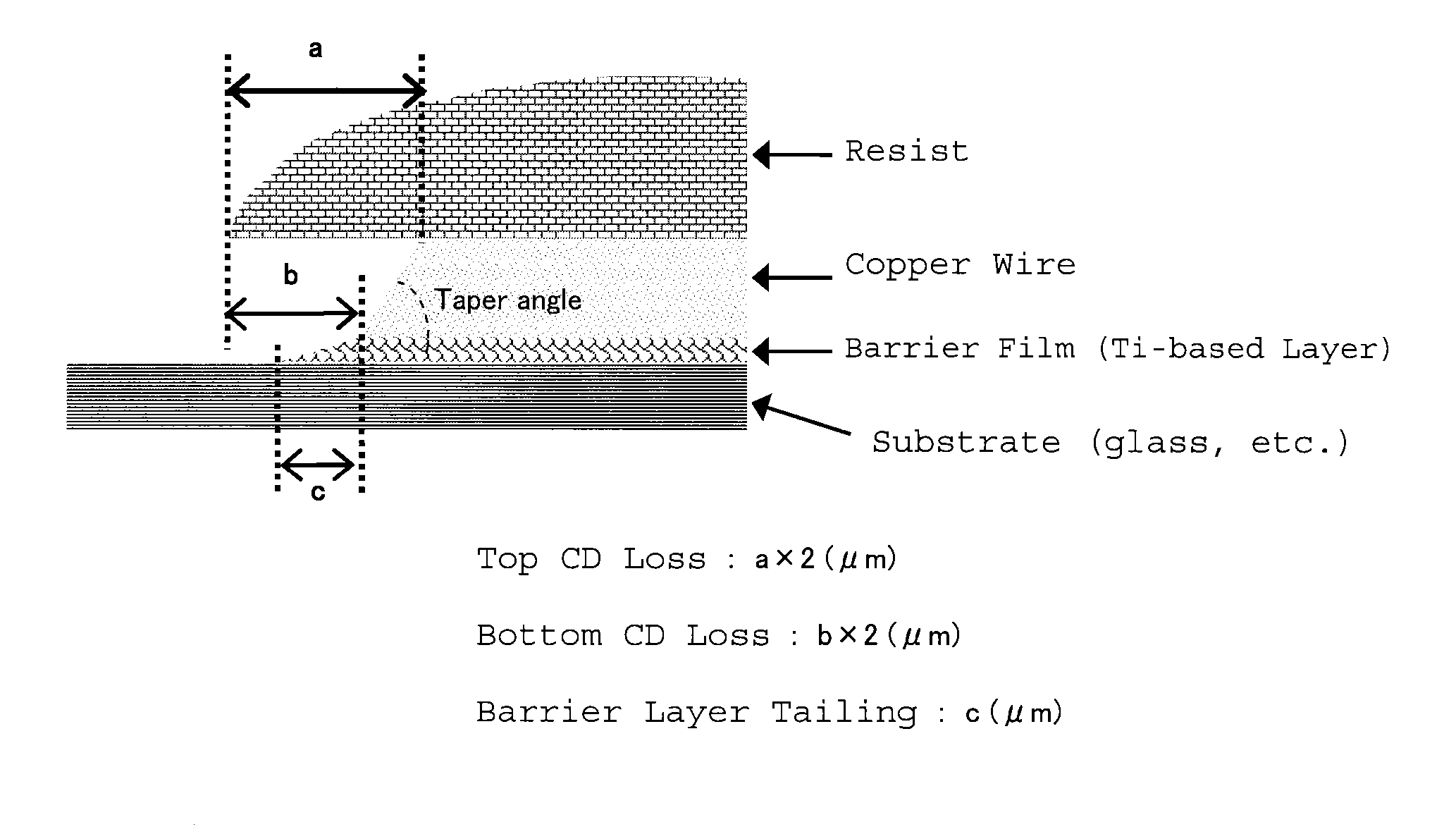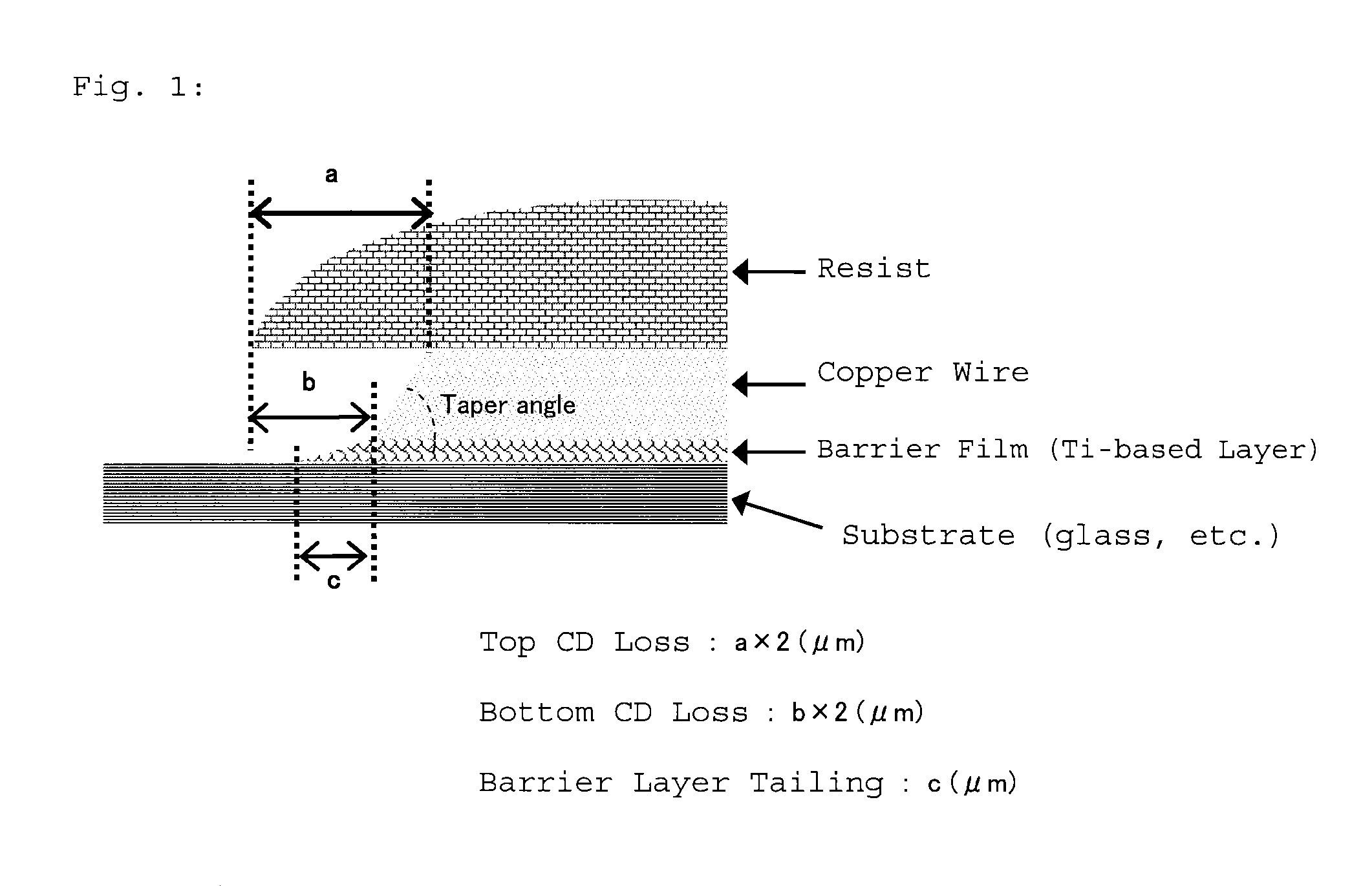Etching liquid for a copper/titanium multilayer thin film
- Summary
- Abstract
- Description
- Claims
- Application Information
AI Technical Summary
Benefits of technology
Problems solved by technology
Method used
Image
Examples
examples
[0034]Next, the present invention is described further in detail by Examples; however, the present invention is not whatsoever restricted by these Examples.
(Observation of Cross Section of Multilayer Thin Film Containing Copper Layer and Titanium Layer after Etching)
[0035]A sample of the etched multilayer thin film containing a copper layer and a titanium layer, as obtained in Examples and Comparative Examples, was cut and observed with a 50000 magnification through scanning electronic microscope (“S5000H
[0036]Type (Model Number)”, by Hitachi) (acceleration voltage 2 kV, acceleration current 10 μA). On the thus-taken SEM image, the taper angle, the top CD loss (μm), the bottom CD loss (μm) and the barrier film tailing (μm) as shown in FIG. 1 were determined.
[0037]Samples of which the taper angle, the top CD loss (μm), the bottom CD loss (μm) and the barrier film tailing (μm) each were within the standard range shown in Table 1 were considered to be good, and the performance of the e...
production example
Production of Multilayer Thin Film Containing Copper Layer and Titanium Layer
[0040]Titanium (Ti) was sputtered onto a substrate of glass to thereby form a barrier film of titanium (titanium layer) thereon, then a copper-based material was sputtered thereonto to form a wiring material film (copper layer), then a resist was applied onto it, a pattern mask was transferred through exposure thereonto, and developed to form a wiring pattern, thereby producing a multilayer thin film containing a copper layer and a titanium layer in which the copper layer was laminated on the titanium layer.
examples 1 to 10
[0041]The multilayer thin film containing a copper layer and a titanium layer, as produced in Production Example, was etched with the etching liquid shown in Table 2, at 35° C. for 60 to 150 seconds, thereby giving an etched, multilayer thin film sample containing a copper layer and a titanium layer, and the amount of the metal dissolved in the etching liquid was measured. Thus processed, the sample was analyzed according to the above-mentioned method to measure the taper angle, the top CD loss (μm), the bottom CD loss (μm) and the barrier film tailing (μm) in the initial bath. In case where the data in this stage still fell within the standard range in Table 1, still another new multilayer thin film containing a copper layer and a titanium layer was etched in the bath, and this process was repeated here. At the time when any of these numerical data came to fall outside the standard range in Table 1, the etching treatment was finished. The amount of the metal dissolved in the etchin...
PUM
| Property | Measurement | Unit |
|---|---|---|
| Percent by mass | aaaaa | aaaaa |
| Percent by mass | aaaaa | aaaaa |
| Percent by mass | aaaaa | aaaaa |
Abstract
Description
Claims
Application Information
 Login to View More
Login to View More - R&D
- Intellectual Property
- Life Sciences
- Materials
- Tech Scout
- Unparalleled Data Quality
- Higher Quality Content
- 60% Fewer Hallucinations
Browse by: Latest US Patents, China's latest patents, Technical Efficacy Thesaurus, Application Domain, Technology Topic, Popular Technical Reports.
© 2025 PatSnap. All rights reserved.Legal|Privacy policy|Modern Slavery Act Transparency Statement|Sitemap|About US| Contact US: help@patsnap.com


